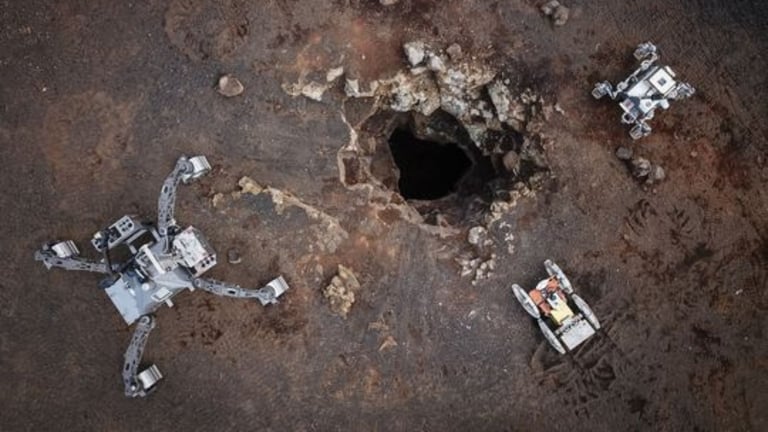Autonomous Robots Conquer Lanzarote's Lava Tubes, Paving Way for Future Space Habitats
August 15, 2025
A team of autonomous robots recently completed a 21-day exploration of a volcanic cave on Lanzarote, Spain, testing their ability to navigate and map subterranean lava tubes, which are considered promising sites for future extraterrestrial habitats.
Lava tubes, formed during volcanic eruptions and found on Earth, the Moon, and Mars, offer natural protection from extreme environmental conditions, making them highly attractive for scientific research and potential human bases.
The study, published in Science Robotics, involved surface mapping at the cave entrance, deploying a sensor cube for 3D mapping, and executing complex tasks like rappelling and deep cave traversal by smaller robots, demonstrating advanced autonomous capabilities.
During the exploration, the robots faced significant technological challenges, including moisture interference with ground-penetrating radar, sensor limitations, and difficulties in autonomous navigation and communication within the complex environment.
Environmental humidity and sensor interference reduced the effectiveness of mapping tools, highlighting the need for improved technology to ensure accurate subterranean exploration.
The robot team comprised specialized units such as SherpaTT, Coyote III, and LUVMI-X, each performing roles like anchoring, reconnaissance, and sensor deployment, showcasing cooperative autonomy in extreme underground conditions.
Researchers have developed a small device capable of levitating solely through sunlight using layered materials, which could enable solar-powered flight by mimicking helicopter rotors.
Current robotic systems depend heavily on pre-programmed algorithms and environmental assumptions, limiting their mapping accuracy due to the lack of ground-truth data, emphasizing the need for better sensor fusion and adaptive algorithms.
Despite successes, robots still face challenges in adaptability to unforeseen obstacles and system failures, underscoring the importance of improving autonomous navigation and error correction for future space missions.
Future space exploration missions will require advanced algorithms and reliable communication systems to allow robots to operate independently over extended periods without human intervention.
Advances in quantum-gravity research are on the horizon, with planned experiments involving advanced lasers and novel matter manipulation techniques that could shed light on the true nature of gravity.
These technological and scientific developments collectively bring humanity closer to establishing a human presence beyond Earth and answering whether life exists elsewhere in the solar system.
Exploring underground environments is challenging for humans due to their inaccessibility, darkness, and hazardous terrain, making autonomous robots essential for initial exploration and mapping.
Summary based on 7 sources
Get a daily email with more Science stories
Sources

Nature • Aug 14, 2025
Daily briefing: These rappelling robots autonomously explore underground tunnels
The Daily Galaxy - Great Discoveries Channel • Aug 15, 2025
Next-Gen Robots Could Unlock Hidden Caves on Mars and the Moon
Universe Space Tech • Aug 15, 2025
How robots to search for shelter on the Moon: Successful tests in a lava cave
Orbital Today • Aug 15, 2025
Scientists Sent Robots Into Lava Tube in Spain, Preparing for Alien Life Hunts